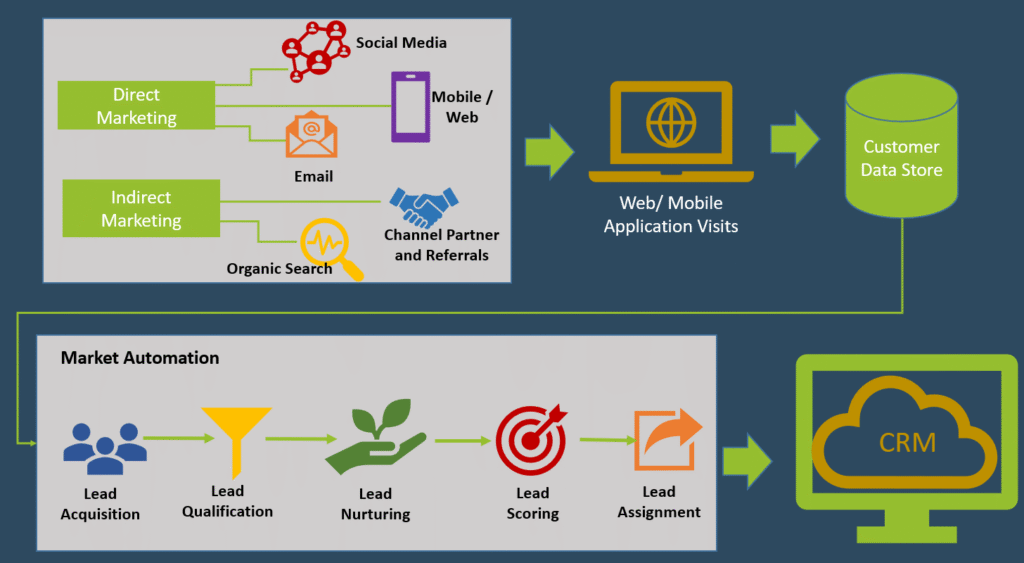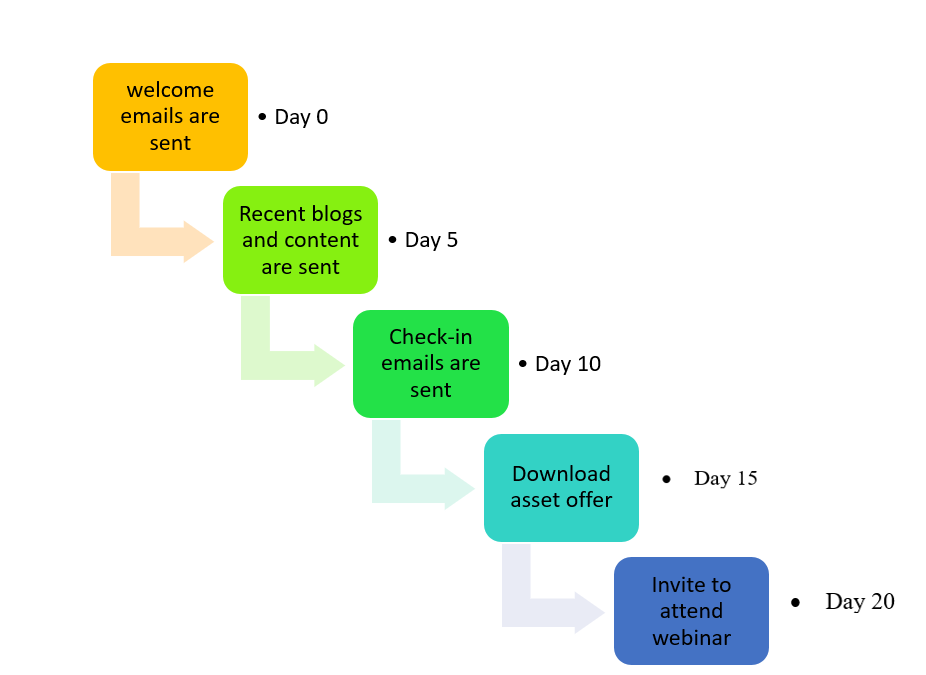
Marketing Automation
Organizations with a sizable inflow of users on their website or mobile application grapple with the task of managing these leads for effective conversion. Users looking at your products/services may…
Organizations with a sizable inflow of users on their website or mobile application grapple with the task of managing these leads for effective conversion. Users looking at your products/services may have a different level of awareness about the offerings, could be influenced by a competitive product, or may just be a passive seeker – not actively looking to purchase your products or services.Each of these users needs to be nurtured with the right level of communication personalized to their own needs. This can quickly spiral into enormous,repetitive, time-consuming activities forthe marketing team. Marketing automation solutions such as Hubspot, Active Campaign, Netcore, can help by automating repetitive marketing tasksdesigned to nurture prospectsat different stages of their journey towards conversion.
ROI on Marketing Automation
- According to Invespcro, 80% of companies saw an increase in leads because of marketing automation.
- Business2Community puts the average increase in qualified leads due to marketing automation at 451%
- According to figures from Marketo, 76% of companies that implement marketing automation in their business process generate a return on their investment within the first year. Not only that, but 44% of them have seen a return just within six months.
- Statistics from Protocol80 suggest that an average of 15-20% of potential buyers that weren’t ready to purchase were converted to sales through automated lead nurturing.
What can marketing automation do for you?
Problem: Different users take different journeys to conversion or drop-out. How do I ensure I engage them individually at every step?
At different stages of their sales journey, users may have unique needs to know about a product or product features. They may also exhibit a peculiar resistance to conversion and may have different preferences regarding how and when they would like to hear from businesses. With this diverse user behavior, there is a need to send personalize and relevant messages without crowding a user’s space. Marketing automation can help you design a workflow to orchestrate a step-by-step communication plan aligned to the user’s needs.
Problem: Most of my time is spent on routine marketing activities. How can I improve marketing efficiency?
Marketing automation helps to improve marketing efficiency by automating the communication process for the target audience, which wouldotherwiseinvolve extensive manual labor. The automation of marketing workflow can involve triggering actions basis certain user events. Thisway, marketers do not have to keep a tab on the current stage of a user. The automation takes care of sending appropriate messages to the user basis his needs at that point of time. This frees marketers to focus on other strategic activities such as designing campaigns and re-aligning efforts to drivesales.
Problem: There is increased users’ traction but not enough sales. Which users should I focus my energy on
Marketerswant to make sure they are focusing their effort on the right leads that havethe potential to get converted into buyers.The MA solution considersa user’s attributes, interests, behavior, journey, etc.,to score individual users. This scoring can provide marketers a mechanism to prioritize their marketing efforts leading to improved conversion.
Components of Marketing Automation
Marketing Automation helps automate personalized user communication through triggers and actions.
Triggers: triggers are conditions that help to activate an automated process. It helps to add the contacts (leads) to the automated process in the workflow. You can add multiple trigger conditions to start the same automation process.
Actions: The course of the process after a trigger is known as actions. These actions can be ‘sending out welcome emails’, ‘sending out newsletters to the subscribers’, etc.
Let’s understand some of the building blocks of Marketing Automation.

Landing form Registration/ (lead generation)
How do organizations acquire leads? Well, through many sources. One of these is through the prospect’s visit to the company’s website or application. Some web pages may ask users to fill upregistration forms beforeallowing further exploration. These specially designed pages to collect data are known as’landing form registration’.The user details collected through these forms are used to generate a lead pipeline.
Lead Acquisition
All the interest generated in your product, captured in the form of a mobile app visit or a website visit, forms an active lead. Gathering all these interest points from different sources is essentially the lead acquisition process.It includes filtering, enhancing, capturing, and transferring/routing the leads into appropriate marketing workflows to establish a personalized relationship.
Lead Qualification
Not all the users visiting your website are interested in your product. There can be a lot of unwanted visits that may not be worth pursuing further. This process of deciding whether the prospect fits your ideal profile and is interested in your product, or is justan accidental visitor, is called’lead qualification’. Lead qualification helps you focus your marketing spend on prospects morelikely to become your customers.
Lead Engagement/ Lead Nurturing
An organization may decide on different engagement tactics for its users depending on whether the objectiveis to stay connected with its prospects orhelp its users progress on their buying journey. This personalized treatment to every lead or prospect is known as’lead nurturing’.
It starts by understanding a users’ attributes, interests, and behavior to identify their current stage in buying. These users may also have different information needs. These insights are then leveraged to craft a more personalized communication strategy. The users’ responses to these engagements are considered to plan the next leg of the communication. One of the most common lead nurturing techniques is the ‘drip campaign’.
Email Drip campaign
The drip marketing campaign is an automated way to send out pre-written emails for a specified period to the prospects or the customer. It is done to keep the prospects/customers warm and engaged.Typically, a communication sent out as part of a drip campaign is generic and sent to a subset of users. The data generated during these passive communications, such as email opened, email deleted, etc.,helps track the leads’ activities and gauge their interestin the emails/contents. This data can then be used to formulate strategies in the later stages.
The following diagram shows how a sample drip marketing works:

Lead scoring
Lead nurturing generates a positive response from some users,and they become more encouraged to buy a product or service. Their readiness to be activelyperceived as sales lead is evaluated by assigning them some scores. These scores are numerical values assigned to the leads based on specific criteria fixed by the organizations, such as their response to communication, demographics, professional information, online behavior, etc.
Lead Assignment
Lead Assignmentis also known as lead routing. It is the automated process of distributing the leads among the sales representative to nurture them further in conversion. The lead can be assigned to the sales representative alphabetically or on the next-in-line basis. The organizations can also customize the process according to the lead assignment rule sets. The potential leads are then fed into the CRM system.
When is the right time to invest in Marketing Automation?
Now that we know what marketing automation is, howitdiffersfrom a typical CRM system, and its components, let’s understandyour organization’s readiness to embrace the solution. Following are the good indicators to know if you are ready to embark onthe Marketing Automation journey:-
- You are already engaged in marketing activities across atleast 2 to 3 marketing channels (Display, Search, Social, etc.)
- You have a sizable and steady inflow of leads from the paid and organic Channels every month
- Your business is generating consistent revenue each month
- You already have a manual marketing process to connect with users, and now you are trying to automate it.
- Your current leads exceed the manageable workload, i.e. you do not have enough resources to communicate with each lead generated by your business
Marketing Automation Solutions
HubSpot Marketing automation software helps you attract the right audience, convert more visitors into customers, and run complete inbound marketing campaigns at scale on one powerful, easy-to-use platform. Using Hubspot you can streamline all your inbound marketing activities – manage multiple social media channels, publish blogs, optimize websites, etc,. The powerful workflow helps in designing personalized journeys that nurture the prospects. Finally, you can optimize your marketing effort to deals closed through powerful customer reporting and built-in Analytics.
Active Campaign is another powerful marketing automation tool that allows you to pull info from every offline and online channel (social media, live chat, landing pages, text messaging, etc.) to automate the marketing. In addition, It provides Powerful site tracking to helpengage the customer at an opportune time with email notifications with a complete email template library. All this with impactful reporting to know which marketing automation campaign is helping you convert more deals.
You Might Be Interested In

Unleashing the Power of Large Language Models
In today's digital age, Artificial Intelligence (AI) continues to push the boundaries of what's possible, and one area that's capturing widespread attention is Large Language Models (LLMs). These sophisticated AI…

Death of Third Party Cookie Part 1
By now, all the marketers are aware of Google's plan to phase out third-party cookies in Chrome. It's not too far. By the end of 2023, the third-party cookie will…

Metadata Management Guide
What is Metadata Management? Metadata, in simple terms, is data about data. Metadata Management refers to managing, maintaining and governing the metadata of an organization. Metadata serves many purposes, but…


